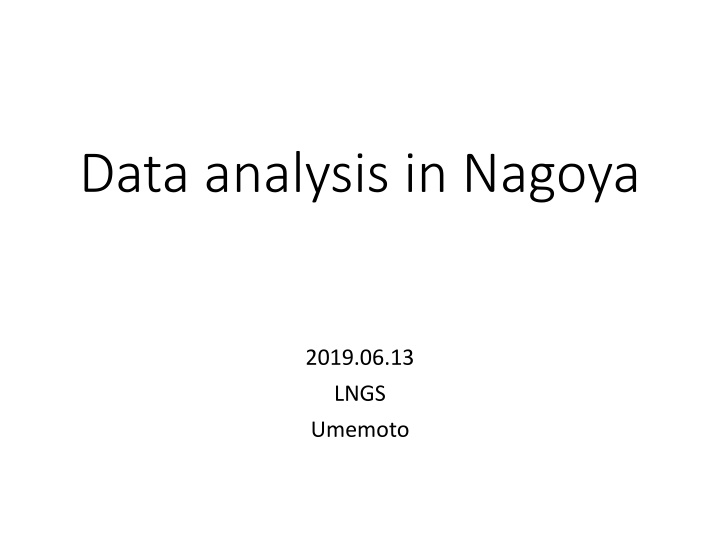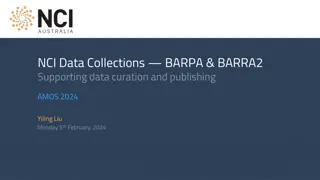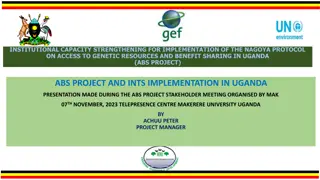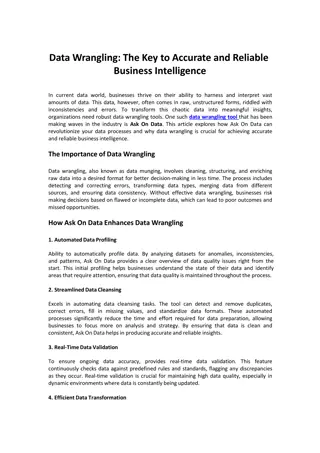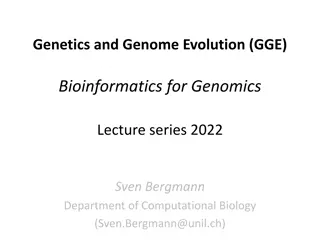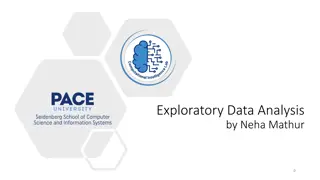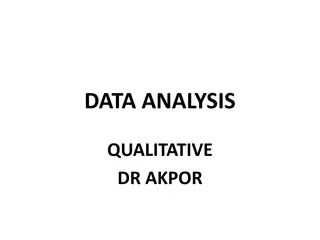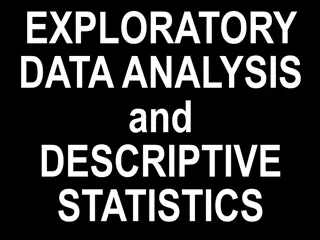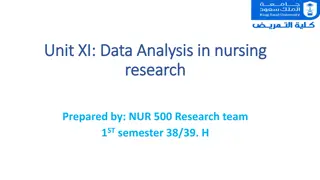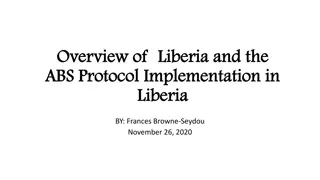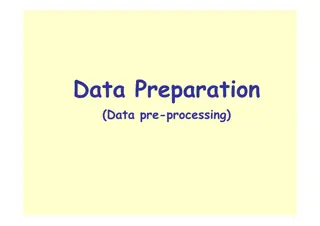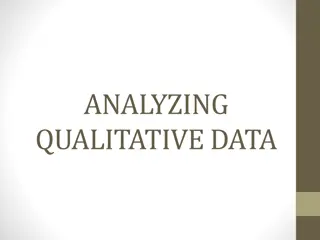Data analysis in Nagoya
In Nagoya, data analysis was conducted on NIT-70 and NIT-40 data matching, focusing on the molecular characteristics of emulsions. The study delved into the crystal sizes and brightness information, aiming to enhance signal-to-noise ratio and detection efficiency. Additionally, the distribution of 100 keV carbon brightness, ion distribution, and angular resolution were analyzed. Ellipticity and minor distribution patterns of NIT-40 and NIT-70 were explored, along with the impact of fog and dust on detection outcomes. The study also highlighted the effectiveness of background fog and dust density in identifying signals. Tags: Data Analysis, Molecular Characteristics, Crystal Sizes, Brightness Information, Angular Resolution.
Download Presentation

Please find below an Image/Link to download the presentation.
The content on the website is provided AS IS for your information and personal use only. It may not be sold, licensed, or shared on other websites without obtaining consent from the author.If you encounter any issues during the download, it is possible that the publisher has removed the file from their server.
You are allowed to download the files provided on this website for personal or commercial use, subject to the condition that they are used lawfully. All files are the property of their respective owners.
The content on the website is provided AS IS for your information and personal use only. It may not be sold, licensed, or shared on other websites without obtaining consent from the author.
E N D
Presentation Transcript
Data analysis in Nagoya 2019.06.13 LNGS Umemoto
Contents NIT-70 and NIT-40 Data matching
NIT-70 nm Current standard emulsion has mean crystal size 70 nm It expect to be high S/N by using brightness information
Brightness about 100 keV carbon Max distribution Max distribution NIT-70 NIT-40 NIT-70 NIT-40 NIT-40 NIT-40 2 NIT-40 2 NIT-40 NIT-70 NIT-70 2.8 um 51 pixels Mean distribution Mean distribution NIT-70 NIT-70 NIT-40 NIT-70 NIT-40 2 NIT-40 NIT-40 NIT-70 2 NIT-40 NIT-70 2.8 um 51 pixels Max : Maximum brightness Mean : Mean brightness BG : Background brightness Optical brightness is increased twice if NIT -70 is used. *optical response about =460 nm light depends on the crystal size By plasmon. It isn t clear why twice. 4
Minor distribution 100 keV ion NIT-40 100 keV ion NIT-70 3.66 0.235 (1sigma) 201 13 nm 3.93 0.230 (1sigma) 216 13 nm minor minor Minor value of silver spherical nanoparticle Minor(nm) Minor distribution of ion comes from the distribution of crystal and track grains. Diameter (nm)
Detection efficiency and angular resolution Elliptocity >= 1.25 24.2 % (NIT-40) 29.5 (NIT-70) NIT 40 has better angular resolution several degrees. 2025/2/28
Fog and dust 2025/2/28
Ellipticity and minor distribution NIT 40 100keV carbon NIT 70 100keV carbon Ellipticity Ellipticity Minor Minor NIT 40 MAA ref NIT 70 MAA ref Ellipticity Ellipticity Minor Minor
Ellipticity and minor distribution NIT 40 100keV carbon and Maa ref NIT 70 100keV carbon and Maa ref Ellipticity Ellipticity Minor Minor Minor cut is effective to identify the signal. We set the cut like below. NIT-40 3.3 <= minor <=4.1 NIT-70 3.6 <= minor <=4.4
Background fog and Dust Density (/(10um)^3 FAN112gf (NIT-40) FAN123gf (NIT-70) 0.1910 0.0402 0.2496 0.0569 All w / Minor cut 0.0814 0.1476 Error is not Estimated yet w/ minor and elli cut Ellipticity>=1.5 0.0023 0.0036 Density (/ view (100000um^3) =0.34ug) FAN112gf (NIT-40) FAN123gf (NIT-70) 19.10 4.02 24.96 5.69 All w / Minor cut 8.14 14.76 w/ minor and elli cut Ellipticity>=1.5 0.23 0.36
Ellipticity distribution of MAA ref Ellipticity distribution after minor cut each other Number of event / view NIT-40 (FAN112gf) NIT-70 (FAN123gf) Elipticity
Ellipticity and Max brightness NIT 40 100keV carbon NIT 70 100keV carbon Ellipticity Ellipticity NIT-40 3.3 <= minor <=4.1 NIT-70 3.6 <= minor <=4.4 Max-BG Max-BG Event density /view NIT 70 MAA ref NIT 40 MAA ref NIT-40 3.3 <= minor <=4.1 Ellipticity NIT-70 3.6 <= minor <=4.4 Ellipticity Max-BG Max-BG
Ellipticity and Max brightness NIT 40 100keV carbon *Fog in carbon sample is not subtracted NIT 70 100keV carbon Ellipticity Ellipticity Max-BG Max-BG Higher detection efficiency can be archived in NIT70 NIT 70 MAA ref NIT 40 MAA ref Ellipticity Ellipticity e.g. Event selection cut with lower dust event number Max-BG Max-BG
Ellipticity and Max brightness NIT 40 100keV carbon *Fog in carbon sample is not subtracted NIT 70 100keV carbon Ellipticity Ellipticity Max-BG Max-BG Higher detection efficiency can be archived in NIT70 We aim to achieve the high S/N by using brightness information like above cut. Dust is dominant in current our BG, it is better to make a low BG state. NIT 70 MAA ref NIT 40 MAA ref Ellipticity Ellipticity e.g. Event selection cut with lower dust event number Max-BG Max-BG
Prospect I can not finish summarizing of detector performance and the amount of dust , NIT-40 and NIT-70. I continue this work and report in video meeting. Additional Sensitivity of gamma should be evaluated between NIT-40 and NIT-70. Detection efficiency of lower energy ion with brightness cut. Neutron analysis
For Combine analysis current situation We passed several samples which already scanned Japanese microscope PTS2 to Napoli for evaluating the relation between Japanese elliptical parameter and polarization analysis. Sample list: Carbon ion : 100 keV, 60 keV, 30 keV horizontal and 30 keV vertical. MAA reference, Am241 Gamma Problem Most of sample were scanned by Asada in Napoli but the evaluation did not be finished because event matching did not work well. In PTS2, scanning speed is more important than the accuracy of position about stage movement (current position accuracy about 3 um). The combined analysis was stopped .
Local matching The positional displacement can be corrected using pattern matching of detected event in each view. How to : 1 : rough pattern matching was done between Japanese and Napoli data by moving the position distribution of one stage (1 um pitch) with changing the rotation angle. roughly affine parameter was got. 2 : fine pattern matching was done by using rough affine parameter with 0.1 um pitch without changing the rotation angle 3 : event by event matching by selecting closest candidate after fine affine transformation and tagged * Shiraishi san is the main developer of this analysis. Special thanks to him.
Try matching with only parallel translation JPData DMRoot There is a rotation due to a sample setting or camera. We set a rotation angle estimated from this event position distribution as a initial value
Difference of scanning system stage coordinate Camera condition +y JP Np Pixel size 55 nm 27.4 nm Cols 2048 pixel 112.6 um 2320 pixel 63.5 um Rows 2048 pixel 112.6 um 1720 pixel 47 um +x Japan Stage +y +x Napoli Stage
C100 keV scanning Flow 1 : Japanese scanning with Zigzag line movement. (100 um pitch 1mm 1.1 mm) 2 : Napoli scanning as same as JP. Scanned view coordinate was corrected by OP mark. with blue LED () Opticalmark Position Japan (mm) Napoli (um) Op1 (x,y) (0,0) (-0.2,-0.1) Op2 (x,y) (5.2305, 0.136) (-5209.1 -490.1) Op3 (x,y) (-2.7165, -17.822) (1497.2, 17962.1) Op4 (x,y) (6.2055, -18.432) (-7454.4 ,17967.4) Japan (mm) Napoli (um) Start position (1.8035 ,-8.449) (-2376, 8306) Measured by JP microscope estimation calculated by Affine transformation using opticalmark position
Event selection for using pattern matching JPData Difference layer from surface Napolidata 3 layers used Two peak?? 0<gr.z<0.6 looks ion signal region Surface layer distribution View ID Parameters and selection x = -gr.x y = -gr.y x = (cl.px-1024)*0.055 y = (-cl.py +1024)*0.055 Cut condition hd.aid== iView &&hd.flag==0 && abs(gr.z)>0 && abs(gr.z)<0.6 Cut condition hd.id== iView &&hd.flag==1 && abs(cl.z-hd.surfLayer)<=3
How to obtain polarization parameter Napoli data was scanned by Asada and root file was uploaded in http://emulsion.na.infn.it/export/NEWS/70nm_matching/2018Apr29_70nm100keVRe_Taping_Matching/ RunHeader has no information in this time. 1. The position and other parameters were obtained from DMRGrain with selection (hd.flag==0&&gr.z>=0&&gr.z<=0.6&&gr.npx>=10). 2. If pattern matched was successful, we tagged Japanese event with DMRGrain 3. All DMRCluster belonged to DMRGrain were listed and DMRCluster of the best focus layer with all polarized angle were found. Our source codes are uploaded Git and made by Cmake . Please tell me, if you want to get the source code.
Affine parameter of matching Displacement between Napoli and Japan system X direction Y direction Displacement (um) X + direction movement in JP Displacement was generated by Japanese stage. X - direction movement in JP localized Y direction move Each 11 views (100 um) view Rotation angle between Napoli and Japan system Rotation angle (degree) Rotation angle was constant. view
Matched event number Event number in each views Number/view PTS2 This difference comes from the view size. effective area of PTS2 is normalized to Napoli. Napoli PTS2: 1 view = 11502.56 um^2 Napoli : 1view =2995.83 um^2 matched view After normalization of event number Number/view Most of candidates of Japanese data are matched. Napoli PTS2 normalized matched view
Barycenter shift After matching Distribution of number of polarization angle owned in candidate Polarization data can be obtained with referring your source (DMRView.cpp) TObjArray* DMRView::GetCLofGRbf( int igr ) *in this time, DMRRun header and DMRFrame are null, so we can not use your source. Peak come in npol=7 There are many events with npol >8 instead of observation was done with 8 polarization angle (0~180, 22.5deg pitch) cluster was separated to 2 or 3 due to Plasmon ?? npol and barycenter shift Bshift(um) Barycenter shift is defined as the maximum distance of two grains using all belonged clusters. In this time, we have no chance to discuss the method to get barycenter shift with Napoli people. After meeting, we would like to discuss. npol
Relation between ellipticity and barycenter shift Ellipticity and barycenter shift Bshift(um) Cut : 3.6<=Jp minor<=4.4 A correlation ! Ellipticity The signal region was defined as below to detect track length and angle. JP: ellipticity >=1.5, Napoli: Barycenter>=0.1 um
Phi angle relation Phi angle distribution by Napoli and JP analysis Phi of barshift direction The difference of detected angle between Napoli and JP analysis Difference of angle(degree) Phi of JP elliptical Ion beam direction the detected angle by Napoli Polarization analysis corresponds to that of Japanese analysis. 1 sigma of angular accuracy between JP and Napoli is 6.6 degree.
Relation between ellipticity and barycenter shift Cut : 3.6<=Jp minor<=4.4,Ellipticity >=1.5 0<Bshift<0.05 um Ellipticity and barycenter shift Bshift(um) Japanese angular distribution Barycenter angular distribution Ellipticity The reason is not clear why higher ellipticity event has lower barycenter shift. These events are categorized in nano-track??
Relation between ellipticity and barycenter shift Cut : 3.6<=Jp minor<=4.4,Ellipticity <1.25 0.2 <=Bshift Ellipticity and barycenter shift Bshift(um) Japanese angular distribution Barycenter angular distribution Ellipticity We want to know the relation between Bshift distribution and brightness. I think these are low brightness??
Prospect Understanding detail about Napoli analysis data of Carbon signal, fog and dust (also gamma). - Please tell me the characteristic of signal. Current, we use only barycenter shift and temporary cut parameter about npx. Next, we try matching about Dust and compare the parameters. - then, the structure is different from ion sample. After meeting, I will do in Napoli. After that, neutron sample and Run sample should be analyzed.
Out put file out.dat : DMRGrain [DMRCluster] JPCluster iv x y npx mean max minor major angle x y npx vol [ipol x y] 0 -29.6241 -7.98765 32 61.25 99 3.70832 4.4406 49.0816 -29.6814 -8.0144 10 34 1 36.8667 22.3342 2 36.857 22.3377 0 -28.331 -3.3561 41 88.7805 159 4.06127 5.24882 83.7458 -28.3779 -3.39053 14 65 1 35.5584 17.7135 2 35.5487 17.6993 3 35.5473 17.712 4 35.5544 17.704 5 35.557 17.7059 6 35.5582 17.699 7 35.5392 17.7099 0 -25.5235 -0.105602 42 93.0476 203 4.14679 4.41712 81.1456 -25.4806 -0.112776 115 1324 0 32.6555 14.4564 1 32.661 14.4573 2 32.6601 14.4503 3 32.6618 14.4491 4 32.6634 14.4407 5 32.6649 14.4359 6 32.6657 14.4331 7 32.6642 14.4378
NIT-70 (FAN123gf) NIT-70 (FAN123gf) 70000 1200000 Difference of event number of each bin/1g 60000 1000000 50000 expected dust number /1g 800000 40000 600000 30000 Series1 400000 20000 200000 10000 0 0 0 50 100 150 200 250 300 0 50 100 150 200 250 300 Max-Bg Max-Bg
